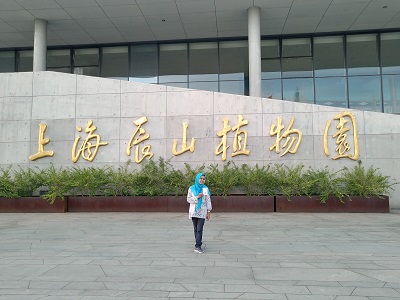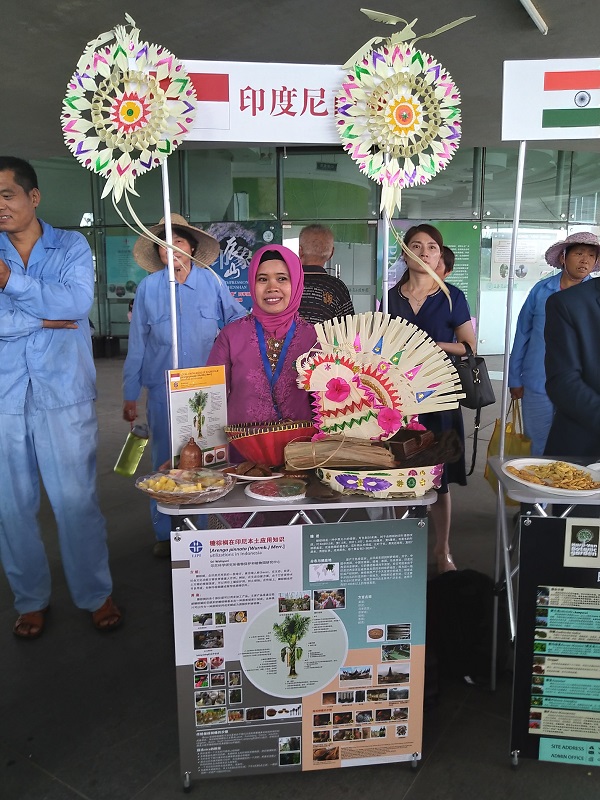|
I am a researcher of Bogor Botanic Gardens, Indonesia. 2019 in Shanghai Chenshan Botanical Garden (SCBG) was the first that I attended and it was also my first visit to China. This is also important to my research and to relevant programs on the development of new Botanic Gardens in Indonesia. I believe that the course will improve and enrich my knowledge and skill in managing and developing botanic gardens, which will benefit our institution. The method provided in this training activity was very comprehensive. The training course began with an opening and welcoming ceremony by the Director of Shanghai Chenshan Botanic Garden and management board. The program included theory classes, guided tours, field trips, visits, and trainee duties. Both of the theory classes and guided tours in the garden provide the trainee with knowledge and insights on how to well manage the botanical garden. All of the teachers in each subject and tour guide are experts in their fields. I always get something new from all the teachers. The garden consists of central display area, native plants conservation area, scientific research zone and a perimeter buffer area for a total size of 207 hectares with a unique landscape. Moreover, SCBG has very advanced technology and financial support from the government to manage botanical gardens properly. 
I was also very happy to have the field trip experience to Mount Tianmu, Hangzhou, Zhejiang, in eastern China. In this field visit, we learned more about connecting plant populations in situ with ex situ plant collections, making specimens, using smart applications that we could download on mobile phones. This application is very user friendly. In addition, we knew how the Chinese government properly protects and maintains their biodiversity in forest and mountain regions and also provides good environmental services. The trainees were very fortunate to have the opportunity to visit the top botanic gardens including Shanghai Botanical Garden which has the spectacular bonsai living collection and Hangzhou Botanical Garden which has wonderful scenery and an excellent environment. Then we visited traditional parks including Zubaichi Park in Songjiang District and Fangta Park or Songjiang Square Pagoda in Suburban Shanghai. We also visited Shanghai Natural History Museum, Shanghai. It is the biggest natural history museum in China. The committee also invited the trainees to visit the Shanghai city iconic place, the Bund. Looking across the Huangpu River, dense high rises in Pudong New Area on the opposite bank, represented by the Oriental Pearl Tower, World Financial Center, Jin Mao Tower, and Shanghai Tower, top four highest skyscrapers in the city. At night, when the lights of the buildings on both banks of the Huangpu River are illuminated, the Bund displays its most fantastic side. One of the most unforgettable moments of the training program is to attend the International Ethnobotany Exhibition. It was very exciting where each trainee must wear traditional dress from their country, presenting dance performances or singing folk songs. This is my first time dancing in public. International ethnobotany show is an opportunity for trainees to communicate with local tourists and practice education in Botanic gardens. It also opens our horizons about the culture of the 14 countries of origin of trainees. This is an incredible opportunity. In this event, I introduced Sugar palm [Arenga pinnata (Wurmb.) Merr.]. Sugar palm has traditionally been used for many purposes. All parts of the sugar palm can be used and processed for various products. I brought some sample products that were used in my exhibition booth such as palm sugar, sweetmeat, fiber (ijuk) rope, brooms, traditional basket, woven plate, hat, and hanging decorations from young leaves. International Ethnobotany Exhibition was successful. The visitors enjoyed all of the performances from the trainees. I felt pleased because my exhibition booth was among the most visited. 
Moreover, I had a walking tour of the Old Town. We visited a Buddhist temple where monks live. Then we visited Songjiang mosque, which is the oldest mosque in Shanghai. Then we visited some centuries-old houses and museums and art galleries in these houses. Then we visited an ancient stone bridge “Dacang Bridge” in west of Sonjiang District. Also we visited the commercial street in the old town. We took the local bus and also had a 2 km walk. This walking tour is organized and accompanied by An personaly. In the one day vacation, we walked around to supermarket, local market and then enjoyed a tea party at a friend’s house. China is known as a Kingdom of Tea. It was my first time to drink tea in traditional Chinese style. We tried to drink some kinds of tea, namely Chinese green tea, oolong tea, white tea and black tea. When the last day came, I just realized that how time flies. IABG training program has given me new knowledge, new skills, new experiences, new places, new foods, new friends and strengthened new networking. I am heartily thankful to the Research Center for Plant Conservation and Botanic Gardens, Indonesian Institute of Sciences, Department of International Cooperation of the Chinese Ministry of Science and Technology, Shanghai Chenshan Botanical Garden, and International Association of Botanic Gardens (IABG), IABG Asian Division and management team for giving me such a wonderful opportunity to join the training program. I wish to have an opportunity to get an internship, become a visiting researcher , have research collaboration or attend a PhD program in Shanghai Chenshan Plant Science Research Center, Chinese Academy of Sciences in the future. I want to learn more about research and technology on domestication, propagation, breeding, and commercialization of ornamental plants at Ornamental Plant Resources, Germplasm Innovation and Utilization Group.
|

